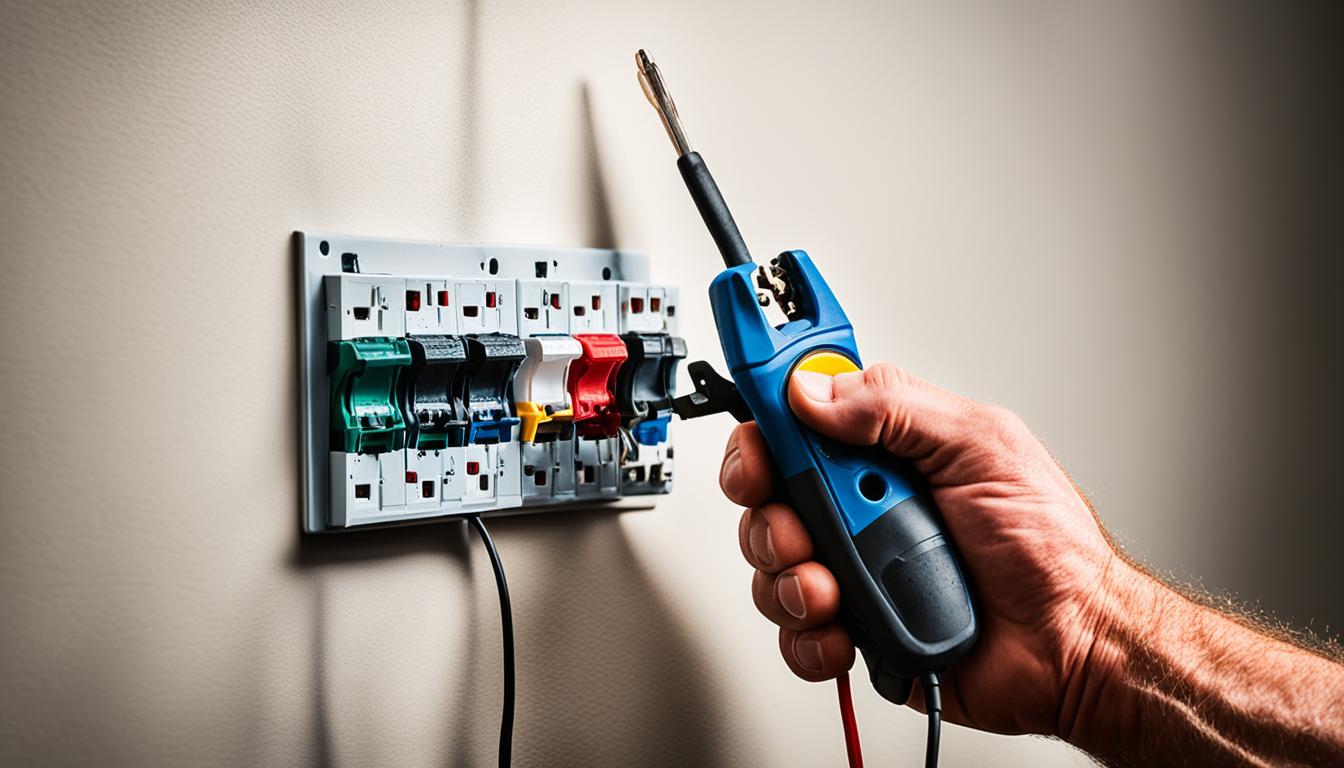Hello! I’m thrilled to present a complete guide on how to install outlets. It covers wiring a wall outlet, setting up an outdoor power outlet, and connecting electrical wires to an outlet. This guide gives you the confidence and knowledge for your project.
Setting up outlets looks tough. But, with the right tools and skills, it’s a great DIY project. We will discuss how to find a power source and fix common issues after installation.
It’s good to tip skilled electricians for their work. Yet, doing it yourself saves time and money. Let’s start learning to install outlets like experts!
Key Takeaways:
- Installing outlets is a rewarding DIY project that can save you time and money.
- This comprehensive guide will provide you with step-by-step instructions and tips for success.
- If you’re unsure about any aspect of the installation process, it’s best to consult a professional electrician.
- Ensure safety at all times by turning off the power before starting any electrical work.
- Properly rewarding your electrician for their hard work and expertise is important.
The Importance of Recognizing Skilled Electricians
Electricity runs almost everything we do at home today. It powers our gadgets and lights up our spaces. Yet, few of us notice the skilled electricians behind it all. They work quietly, making sure our electrical systems are safe and top-notch. It’s key to understand and value these experts. Their know-how keeps our homes running smoothly and, most importantly, safely.
Understanding the Value of Professional Electrical Work
Electrical work doesn’t allow for any mistakes. To work on these systems, you need deep knowledge and lots of practice. Skilled electricians can manage tricky jobs, like setting up new outlets, with care. They make sure everything is in line with safety regulations and works properly. This stops dangerous problems from happening.
Good electricians see beyond just making things look good. They make sure their work is safe above all else. Following the best safety rules, they check that everything they do is strong and meets official standards. Hiring a pro for electrical jobs means you know your home’s systems are with someone who’s truly skilled.
When Should You Consider Tipping Your Electrician?
Tipping shows you appreciate great service, in electricians’ case, their skill. Although it’s not a must, sometimes saying thanks this way is just right. Think about tipping your electrician when they really wow you in these situations:
- When the electrician surpasses your expectations to make you happy.
- If the job was really hard or took a long time.
- When the electrician shares knowledge or advice about your system.
- For outstanding professionalism and keeping you in the loop throughout the job.
Tipping is your call, and the amount is up to you. It’s based on how complex the job was and how well it was done. A tip can show these pros you appreciate the effort they put in. It encourages them to keep up their top-notch service and standards in their field.
Gather Your Tools and Materials
Before you start, you must gather the tools and materials. This ensures you can finish the job well. Here’s what you need for outlet installation:
- Screwdriver
- Wire cutters
- Tape measure
- Wire strippers
- Electrical tape
- Needle-nose pliers
- Voltage tester
- Wire nuts
- Outlet tester
- Electrical box
Using these tools makes the job safe and effective. Remember, you may need more tools for complex projects. Always check with an electrician or your local code for advice.
There are two main types of electrical boxes to use: ‘old work’ and ‘new work’ boxes.
Understanding the Differences Between ‘Old Work’ and ‘New Work’ Electrical Boxes
Old work boxes fit in existing walls, like in renovations. They allow the addition of outlets without tearing down walls. These have adjustable mounts for a secure fit, even without removing wall parts.
New work boxes go into new builds or when you can reach the wall’s inside. These are put in before the wall finish and attach to the studs. They offer a very stable base.
Picking the right box is crucial for a safe installation. Think about what your job needs and talk to an electrician if you’re unsure of the best type to use.
Now, with your tools and box knowledge in hand, you’re set to proceed with your outlet installation.
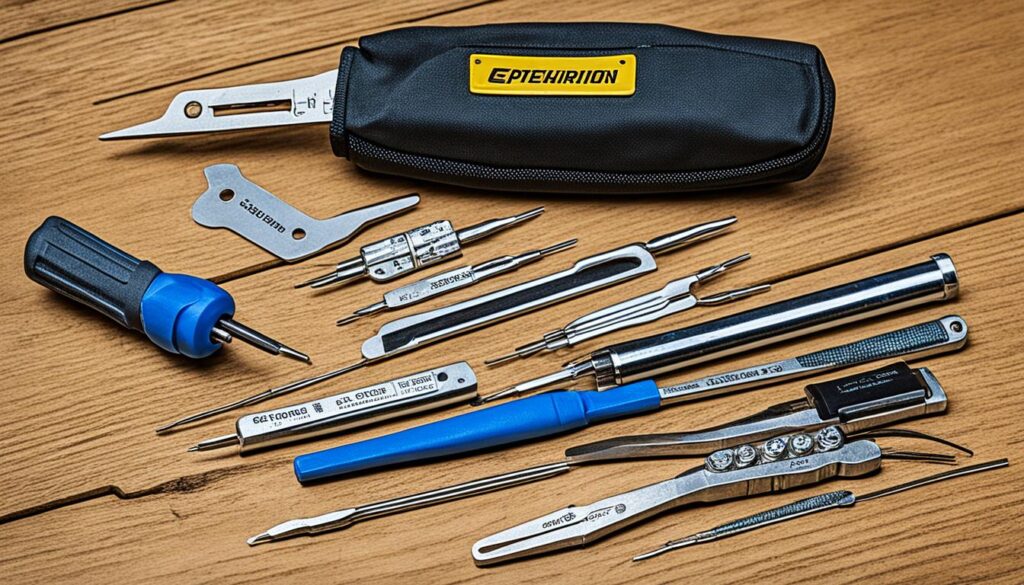
Finding an Appropriate Power Source
Choosing the right power source is vital when adding a new outlet. You need one close by and suitable for the outlet’s needs. Here are some key tips for picking the best power source:
- Find a close electrical circuit: First, search for a circuit near the outlet location. This makes installation easier. Also, check it can handle the new outlet’s load.
- Determine the correct voltage and amperage: Your power source should match the outlet’s needs. This info is often on the circuit breaker. A professional electrician can help if you’re not sure.
- Always test the power source: Before installing, check the power source with a voltage tester. This ensures there are no issues. If you find a problem, call an electrician.
- Think about the outlet’s use: The outlet’s location affects its power needs. For example, outdoor outlets need special, weatherproof power sources. Follow local rules and requirements for the area.
Following these steps will help you choose the best power source for your outlet. Always think about safety and get help from an electrician, if needed. With the right power source picked, you’re ready for the next steps.
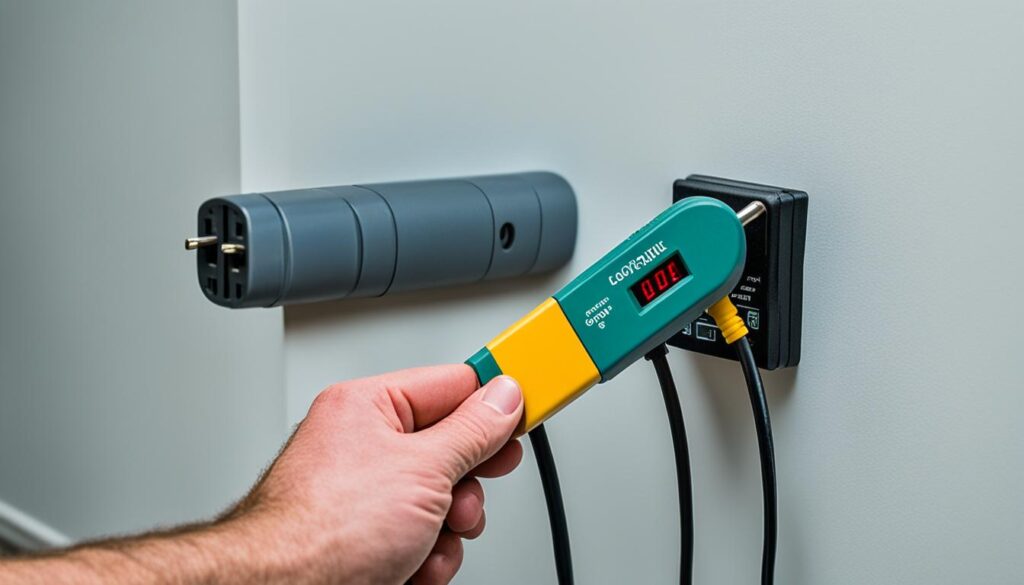
Choosing the Right Location for Your New Outlet
Choosing the right location for a new outlet is very important. It’s key for safety and how well things work. Picking the wrong place could cause problems and even dangers. I’ll give you tips to make a smart choice for where to put your outlet.
How to Avoid Common Mistakes in Outlet Placement
To get the most out of your new outlet and avoid trouble, you must place it well. Here’s what you need to do:
- Do not place outlets back-to-back: Outlets close together can be hard to use. Make sure there’s enough space for your device plugs without blocking them.
- Avoid areas with high moisture: Water and electricity do not mix well. Keep outlets away from wet areas like sinks, showers, and outside spots that get wet. This keeps you safe and prevents damage.
- Consider convenient access: Make sure the outlet is easy to reach. Pick a spot that’s close to where you’ll use it, with no obstacles from furniture or appliances.
- Think about future needs: Imagine the electronics and appliances you might add later. Place the outlet so that it meets future demands without the need for more work or messy extension cords.
By keeping these points in mind, you’ll have a safe, convenient, and functional setup. Now, let’s look at a clear example of where to put outlets:
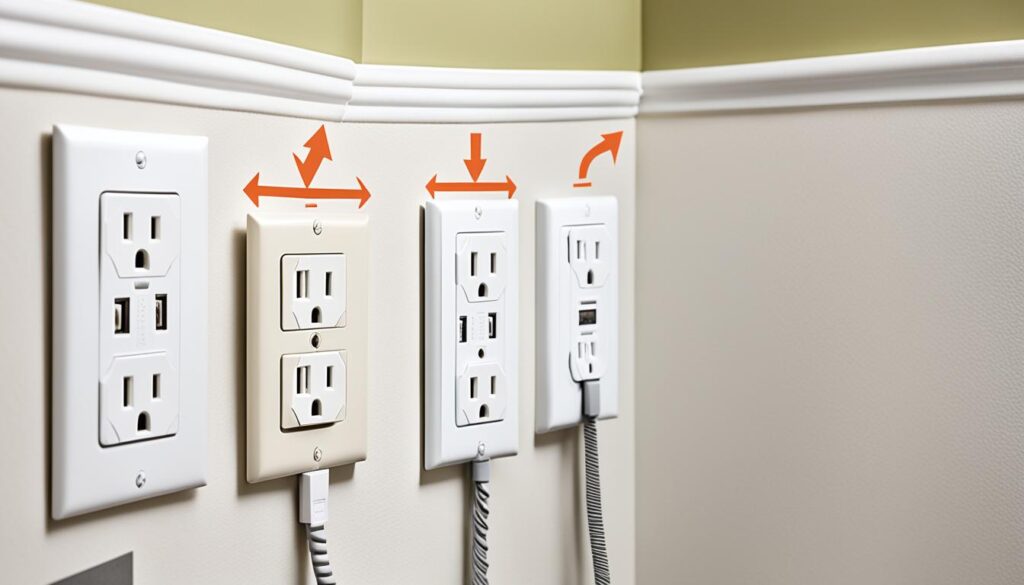
| Common Mistake | Correct Placement |
|---|---|
| Placing outlets back-to-back | Proper spacing between outlets |
| Outlet near a sink | Outlet in a safe, dry location |
| Inconvenient access | Outlet conveniently accessible |
| Insufficient outlets for future needs | Outlet placement accounts for future electrical requirements |
This table shows the wrong and right ways to place outlets. It helps you steer clear of placement mistakes when selecting a spot for your new outlet.
Safe Power Connection Practices for DIY Installation
Doing your own DIY outlet setup means safety first when it comes to connecting power. It’s crucial to follow the right steps and be careful. This helps lower the chances of getting shocked or hurt. Let’s talk about what you need to do:
- Handle electrical wiring with care: Treat electrical wires carefully, and don’t touch live ones. Always use tools with insulation and wear gloves for safety.
- Ensure proper grounding: Grounding is key to avoid electric dangers. Connect the outlet’s ground part to the ground wire firmly.
- Avoid overloading circuits: Too much on a circuit can cause fires. Know how much power your devices need. Then, spread them out across different circuits.
- Turn off the power: Cut the power at the breaker before you start. This helps keep you from getting shocked accidentally.
- Use wire connectors: Use connectors for wires, not just twists or exposed parts. This makes for a safe, solid connection.
By sticking to these safety tips, you can safely finish your DIY outlet project. This way, you keep yourself and others out of harm’s way.
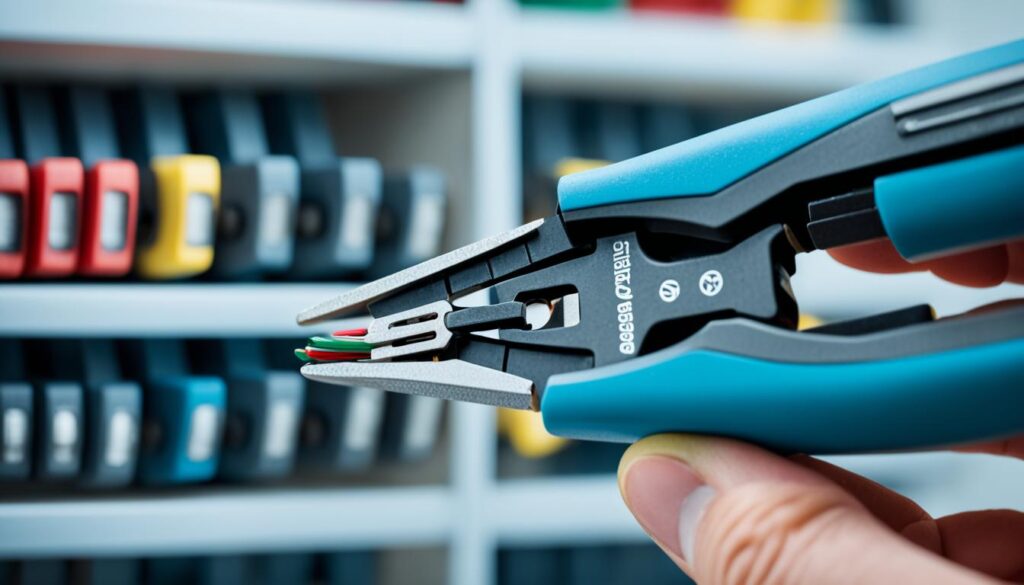
Installing the Outlet: The Step-by-Step Process
Preparing the Outlet Box and Wiring
Before you install the outlet, it’s crucial to prepare the outlet box and wiring. This step ensures a safe connection for your electrical device.
First, make sure the circuit is off at the breaker box. Check with a voltage tester to be sure there’s no power at the outlet.
Then, take off the cover plate and find the wires inside the box. Untwist the wire nuts and carefully pull the wires apart. Strip off about 1 inch of insulation from the wire ends. Do this gently to not harm the wire.
Straighten and organize the wires based on the outlet type. Connect the black wire (hot) to the brass or gold screw. The white wire (neutral) goes to the silver screw. The bare copper wire (ground) attaches to the green screw.
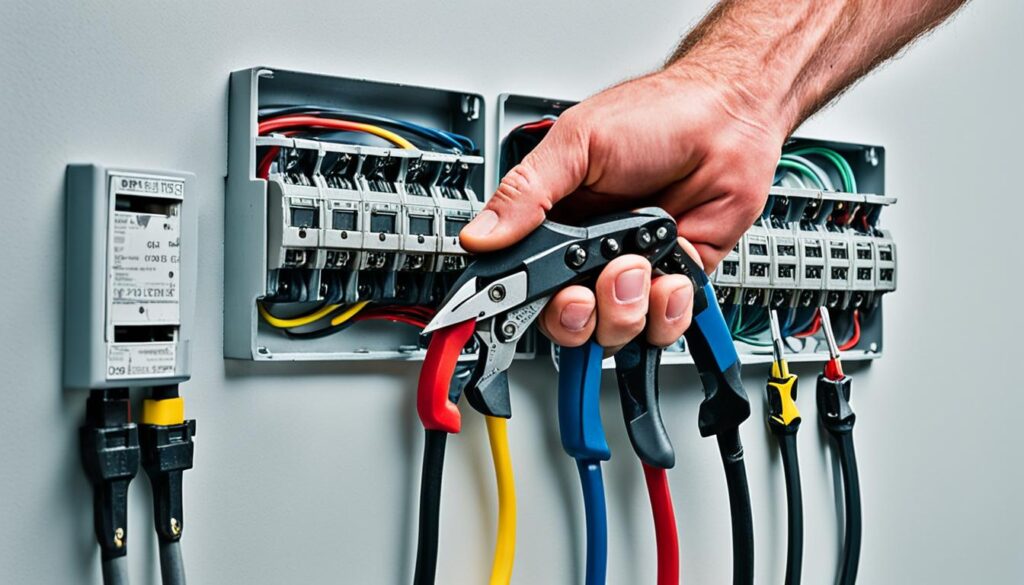
Details on Connecting Wires to Terminals for a Secure Fit
Now, it’s time to attach the wires to the outlet. This task needs careful work to avoid any safety risks.
Make a hook shape at the end of each wire that fits the screw. Loop this end around the screw in a right-handed direction.
Use a screwdriver to tighten the screw. Ensure the wire is firmly secured. Avoid tightening too much, which could harm the wire or outlet.
Once all wires are attached, push them back into the box. Confirm the outlet is level with the wall, and the wires aren’t tangled.
Put back the cover plate. Tighten the screws. Check again that all connections are good before turning the power on.
This method helps you fit the outlet safely. You can trust it’s well-prepared and wired for a reliable performance.
Mounting the New Outlet and Final Touches
Now it’s time to put the new outlet into place. We’ve finished the wiring and connections. It’s all about getting it right for a good look and working electrical. To do this, follow the steps below:
- Secure the Outlet: First, place the outlet in the electrical box carefully. Make sure it’s right, with screw holes in line.
- Next, use a screwdriver to tighten the mounting screws. Remember not to overdo it. Too much force might harm the outlet or the screws.
- Align the Outlet Cover Plate: After that, position the cover plate over the outlet. Check it’s level with the wall. Make any moves to get it perfect.
- Attach the Outlet Cover Plate: Now, use your screwdriver to fix the cover plate. Ensure it’s well secured but not overly so.
By following these steps, you’ll have your new outlet ready to go look-wise, all neat and clean. Make sure it’s all properly secured and leveled. This is key for a top-notch installation.
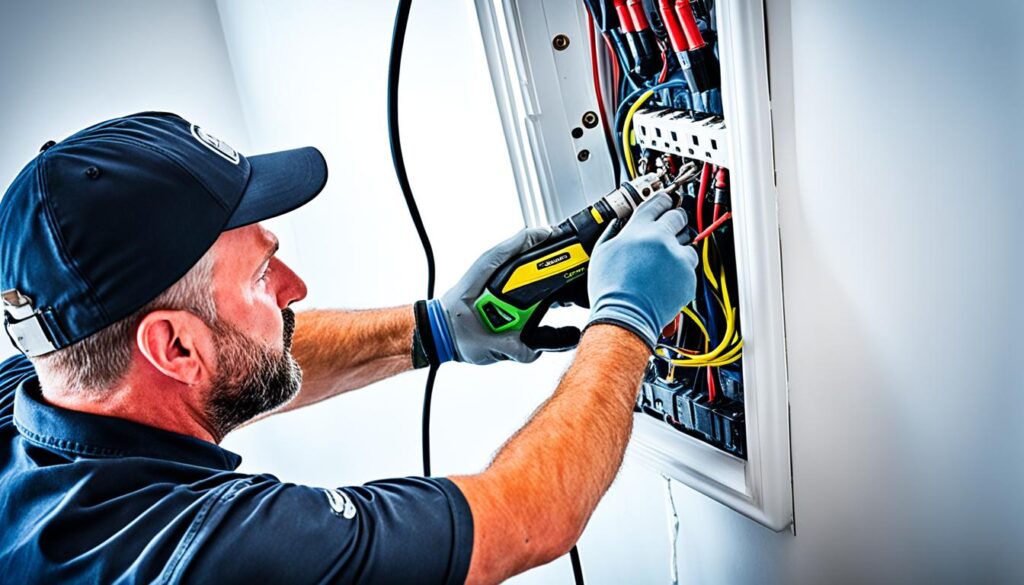
Quality Assurance: Testing Your New Outlet
After setting up your new outlet, checking its quality is key. This check ensures it works well and is safe. I’ll show you how to test it for safety and why a pro finish matters.
How to Use an Outlet Tester for Safety Checks
Test your outlet with an outlet tester, an important tool for any electrical work. It checks if the wiring is good and spots any problems. Here’s how to do it:
- Push the tester’s prongs into the outlet’s sockets.
- Watch the tester’s lights or screen. It shows if the wiring is right or if there are problems like open grounds or reversed polarity.
- Look at the tester’s manual to understand what it shows.
- If there are wiring problems, get an electrician to fix them before using the outlet.
Using an outlet tester makes sure your outlet is safe and correctly wired. It means you can trust your new outlet is secure.
The Importance of a Professional Finish
It’s not just about the outlet working. Making it look neat protects against accidents and makes it last longer. A good finish hides the wires well, keeps them safe, and looks good.
Here’s how to finish like a pro:
- Put the outlet cover on right over the outlet box.
- Make sure to tighten all screws so the cover stays secure.
- Double-check the wiring is secure and well-protected from any dangers.
- Check that the exposed wire parts are covered and fit safely into the screws.
Focusing on these details ensures safety and looks good. It’s worth making it look professional. It keeps your home safe and your outlet working well.
When to Call a Professional Electrician
Some electrical jobs are not safe as DIY projects. Knowing when to get a professional is important for safety. A professional electrician has the skills and tools for complex tasks, ensuring quality work.
Recognizing Jobs That Are Beyond DIY
Not all electrical work is suitable for DIY. Jobs like installing a new panel or fixing high-voltage systems are hazardous. They need a professional’s touch.
- Installing a new electrical panel or circuit breaker
- Upgrading or replacing outdated wiring systems
- Repairing or troubleshooting complex electrical issues
- Installing outdoor or landscape lighting
- Working with high-voltage electrical systems
Letting experts handle these jobs avoids risks. It also guarantees that work is done right and meets safety codes.
Warning Signs: When to Stop and Seek Help
Sometimes, DIY projects show signs that you need a professional electrician:
- Frequently tripping circuit breakers or experiencing power outages
- Noticing dimming or flickering lights
- Dealing with burning odors or sparks from outlets
- Experiencing electrical shocks or tingling sensations
- Encountering damaged or exposed wires
If you notice these signs, it’s time to get help. Waiting could cause more harm and safety threats.
How to Properly Reward Your Electrician’s Hard Work
It’s key to show your electrician you appreciate their hard work. From a simple outlet job to complex projects, their dedication counts. Acknowledging them helps build a positive bond and keeps their service top-notch.
One good way to reward them is with a tip. This shows your thanks in a tangible way. The tip amount depends on the project’s size, how hard it was, and your satisfaction.
But, remember, there are other ways to show your thanks too. Giving positive reviews and recommending them to others can boost an electrician’s career. Your praise to friends, family, or online can highlight their skills and hard work.
“I highly recommend Sam’s Electrical Services. Their electrician, Sarah, went above and beyond to ensure my outlet installation was done correctly and efficiently. I was impressed with her professionalism and attention to detail. I will definitely be referring her to anyone in need of electrical work.” – Happy Customer
Telling the electrician directly how much you value their work is powerful. A thank you note or just saying it out loud matters. It shows you recognize their skill and dedication.
When rewarding your electrician, it’s not all about the cash. It’s about truly valuing their work and commitment. By doing so, you can make a strong, positive connection with them. This also motivates them to maintain their high standard of service.
How Much to Tip for Outlet Installation
When you tip for outlet installation, think about the customs and the job’s complexity. Tipping is a thank you for the effort and skill electricians put in. Being generous in tipping shows your appreciation.
Tipping Guide and Gratuity Customs
How much to tip varies. It depends on the service quality, project size, and the electrician’s skills shown. A standard tip is 10-20% of the total cost. But, adjust this advice to fit your project.
To decide how much to tip, think about:
- Did the work meet your standards and finish on time?
- Did it take special skills or lots of problem-solving to finish the job?
- Did the electrician work extra hard to make sure everything was done right?
Considering the quality of the work helps you see the level of effort. This makes tipping more fair and meaningful. Tipping recognizes great work and thanks the electrician for their job.
Assessing the Complexity of Electrical Work for Appropriate Tipping
For the right tip amount, look at how complex the job was. Think about:
- Did the job need expert wiring or special knowledge?
- Was the job easy or did it need a lot of different parts?
- Did the electrician face tough problems or work more hours than expected?
By thinking about these details, you can give a tip that shows you value the electrician’s work. It’s important to recognize their skills and hard work this way.
When you tip for outlet installation, you’re recognizing their effort. Following tipping customs and considering job complexity help you decide the right tip. A good tip is a thank you for their dedication.
Tips do more than show thanks. They help electricians see the value in providing great service. This can motivate them to keep up the good work.
Troubleshooting Common Issues Post-Installation
Identifying and Rectifying Minor Electrical Problems
After adding a new outlet, you might face minor electrical issues. I’ll share key tips for spotting and fixing these problems. This will help keep your new outlet safe and working well.
Identifying the Problem:
Seeing odd behavior after setting up your outlet? This might be caused by:
- Faulty Wiring: Look for loose or damaged wires in the outlet box.
- Loose Connections: Make sure all connections are tight.
- Tripped Circuit Breakers: Check the circuit breaker panel for tripped breakers.
Systematically checking these issues helps find and fix the problem.
Resolving the Problem:
Found the problem? Let’s fix it. Here’s what you can do:
- Testing the Outlet: Use an outlet tester or multimeter to check power. It shows if the problem is the wiring or the outlet itself.
- Inspecting the Wiring: Check the wiring in the outlet box. Look for any loose/damaged wires causing issues. Fix or replace them as needed.
- Resetting Tripped Breakers: If a breaker is tripped, switch it off and back on. This can solve problems from an overload.
Dealing with electricity is risky. If you’re not sure how to fix it, get a pro. They can manage difficult problems safely.
Use these steps to tackle common issues with a new outlet. Always put safety first and get help if it gets too complicated.
Conclusion
Wrapping up this guide, we see how important skilled electricians are. They are key to successful electrical work. By following the right steps and being safe, a good outlet installation is possible.
An outlet, when installed well, makes life easier and looks good too. Doing this project with care and skill brings a great feeling of accomplishment.
For hard tasks or problems, remember to call a professional electrician. Their know-how guarantees safe and effective work. Showing your thanks with a tip is a nice gesture to appreciate their effort.
Use this guide to confidently set up an outlet in your home or office. Collect what you need, pick the spot, wire it up correctly, and check if it works. You’ll find that installing an outlet isn’t as hard as it seems with these tips.
